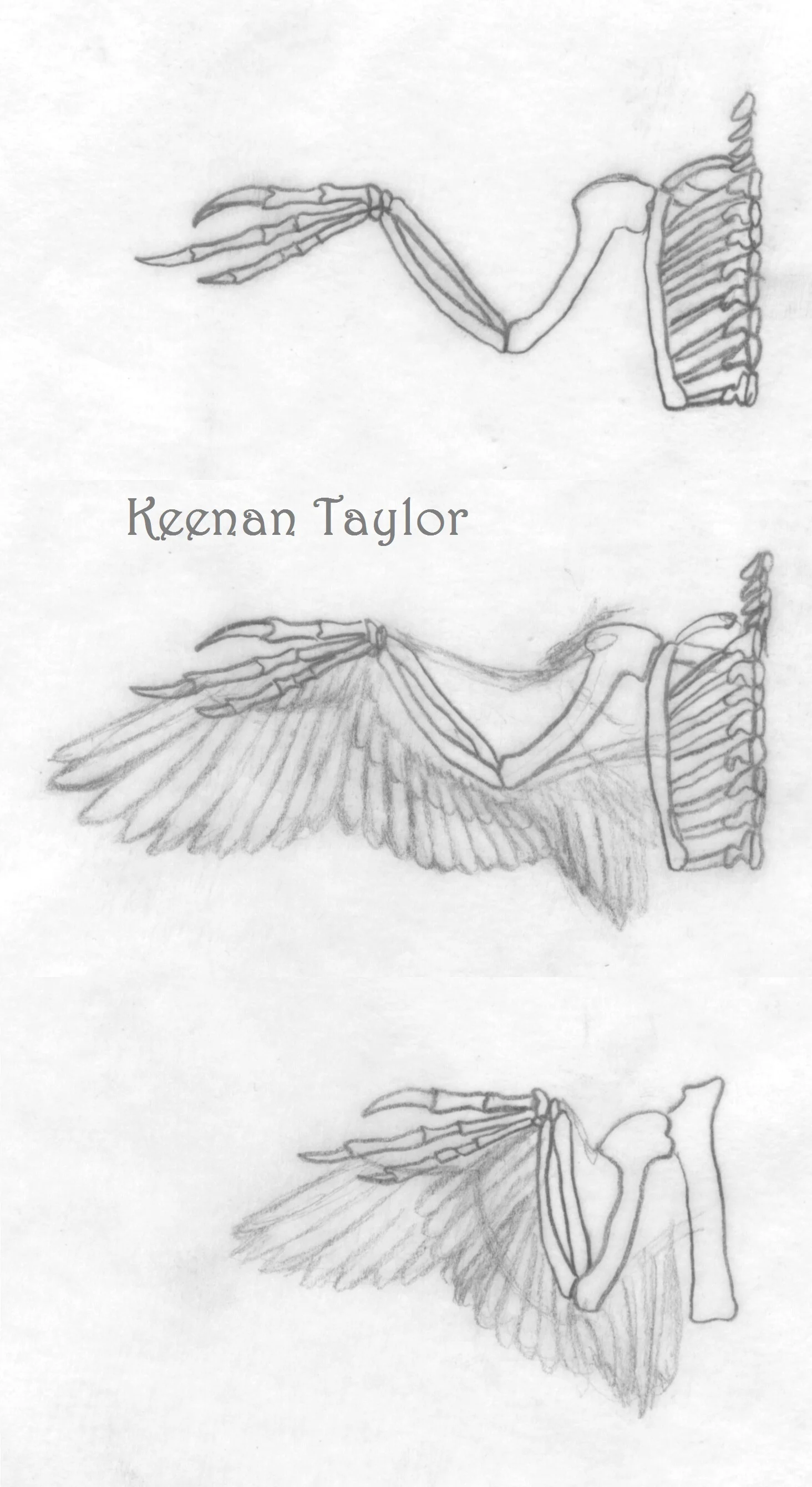Scientific Illustration Portfolio
![Chicken Skull (Gallus gallus)]()
Chicken Skull (Gallus gallus)
The skull of a domesticated chicken (Gallus gallus). An assignment for the UW Natural Science Illustration Program.
Media: stippled pen and ink. 8 by 4 inches.
Time: 25 hours (3 on sketches and value study, 22 on final illustration)
![Unicorn Beetle (Dynastes tityus*)]()
Unicorn Beetle (Dynastes tityus*)
An illustration of the Eastern Hercules Beetle from the United States. Although it was labeled as such, the coloration doesn't match with any references I could find. An assignment for the UW Natural Science Illustration Program.
Media: colored pencil on film. 7 by 3 inches.
Time: 10 hours (2 on research and sketches, 8 on final illustration)
![Little Blue Heron (Egretta caerulea)]()
Little Blue Heron (Egretta caerulea)
Two little blue herons with a bird of prey soaring overhead. An assignment for the UW Natural Science Illustration Program.
Media: colored pencil. 11 by 17 inches.
17 hours (2 on research, 3 on sketches, 12 on final drawing)
![Asiatic Elephant]()
Asiatic Elephant
![African Lion]()
African Lion
![Grizzly Bear]()
Grizzly Bear
![Deer Fern (Blechnum spicant)]()
Deer Fern (Blechnum spicant)
A deer fern (or hard-fern) that I drew during my botanical illustration class. An assignment for the UW Natural Science Illustration Program.
Media: stippled pen and ink, 2 by 8 inches.
12 hours (3 on specimen collection and sketches, 9 on drawing)
![Red Onion (Allium cepa)]()
Red Onion (Allium cepa)
One of the final illustrations for my botanical illustration class. An assignment for the UW Natural Science Illustration Program.
Media: colored pencil. 8 by 4 inches.
8 hours (1 on research and photography, 7 on drawing)
![Male Red Junglefowl (Gallus gallus)]()
Male Red Junglefowl (Gallus gallus)
A small image meant to accompany my poster on the domestication of chickens. An assignment for the UW Natural Science Illustration Program.
Media: colored pencil on drawing paper. 10 by 8 inches.
5 hours (1 research, 4 drawing)
![Domestication of the Chicken poster]()
Domestication of the Chicken poster
My final project for my first course in the UW Natural Science Illustration Program.
Media: digital. 11 by 17 inches.
6 hours (3 research, 3 for digital composition)
![Bonobo Jaw Muscle Study (Pan paniscus)]()
Bonobo Jaw Muscle Study (Pan paniscus)
A study focusing on the chewing muscles of the bonobo (or pygmy chimpanzee). An assignment for the UW Natural Science Illustration Program.
Media: colored pencil. 8 by 8 inches.
10 hours (2 research, 2 sketches and measurements, 6 drawing)
![Deinonychus antirrhopus Wing Study]()
Deinonychus antirrhopus Wing Study
A study of Deinonychus' wings. The number of feathers and placement of the petagium (skin between shoulder and wrist) is based on the related Anchiornis huxleyi, a dinosaur famous for most of its coloration able to be reconstructed. Juvenile Deinonychus may have used this to aid in gliding, although the extent that an adult, clearly flightless Deinonychus would retain it is debatable.
Media: graphite. 3 by 8 inches.
2 hours (1 hour of research, 1 hour for final illustration).
![Deinonychus antirrhopus layer study]()
Deinonychus antirrhopus layer study
The skeletal, muscular, and fully-fleshed reconstruction of Deinonychus antirrhopus. My skeletal is based on a combination of my own photographs of articulated fossils and the work of Scott Hartman. I combined the musculature of an ostrich and an owl to get the most accurate replication I could. The feathers are based on related species, as Deinonychus has not been preserved with any soft tissue.
Media: graphite. Each image is 11 by 4 inches (substituting inches for feet in a scale).
5 hours (2 hours of research, an hour for each drawing).
![Color Study of Deinonychus antirrhopus]()
Color Study of Deinonychus antirrhopus
An important part of my reconstruction of Deinonychus antirrhopus was deciding what coloration I would use in my final illustration. Knowing their predatory nature and floodplain environment gave me clues, along with the knowledge that they were feathered based on related animals (Velociraptor, Dakotaraptor, Sinornithosaurus, etc.). These are all inspired from a variety of water birds and birds of prey, such as herons, eagles, and owls. The top left image, based on a horned owl and a red-tailed hawk, was the one I chose to use for my project.
Media: colored pencil, each 1 by 2 inches
3 hours (1 for research, 2 for drawing)
![Deinonychus antirrhopus skeleton]()
Deinonychus antirrhopus skeleton
A full skeletal reconstruction of Deinonychus antirrhopus' skeleton for my final project. An assignment for the UW Natural Science Illustration Program.
Media: colored pencil. 7 by 15 inches.
15 hours (2 for research, 1 for articulation, 12 for final illustration).
![Deinonychus antirrhopus on Zephyrosaurus schaffi]()
Deinonychus antirrhopus on Zephyrosaurus schaffi
My final reconstruction of Deinonychus antirrhopus, a predatory dinosaur from the early Cretaceous period, for one of my courses at the UW Natural Science Illustration Program. The coloration is based on the great horned owl and the red-tailed hawk. I have reconstructed it with ear tufts like a modern horned owl. This decision was made thinking that it might be an aid in hunting and communication since there is evidence that they were social animals, but this particular feature is pure speculation and has no evidence to support it. This Deinonychus is presented perched on a male Zephyrosaurus schaffi, a small burrowing dinosaur that shared Deinonychus' habitat.
Media: colored pencil on film. 8 by 16 inches.
20 hours (3 for research, 1 for preliminary sketches, 16 for final illustration).















